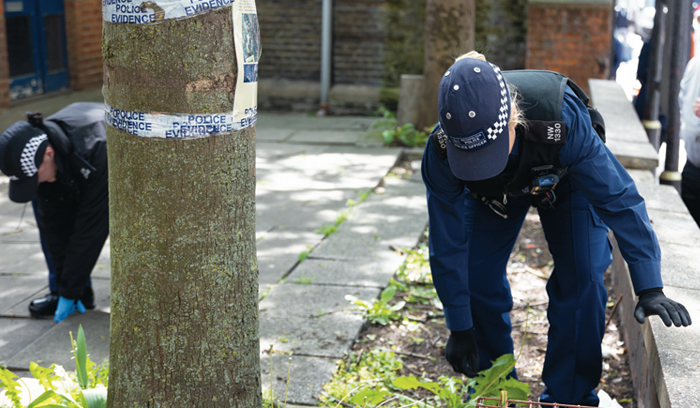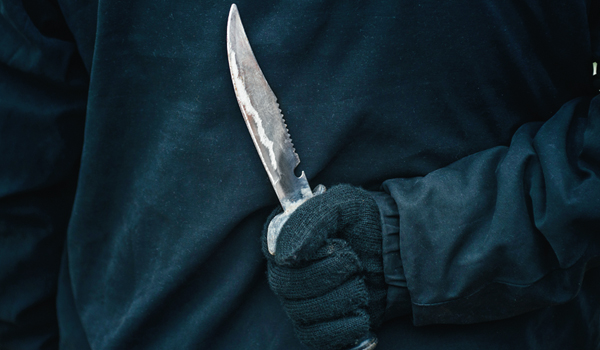Sharp focus needed
Knife crime has increased in England and Wales over the past decade – Dr Toby Davies and Professor Graham Farrell examine how the next government can prevent it.
Shocking news stories, such as the conviction of two 12-year-old boys for a fatal machete attack in Wolverhampton, have fuelled worries of an “epidemic” of knife crime in England and Wales. A new survey of 2,000 young people found that nearly half are worried about knife crime. In their campaigns for the forthcoming election, both Labour and the Conservatives have promised to take action on knife possession and violent crime.
Knife crime appears to buck the trend of an overall decline in crime in recent years. Although England and Wales are still among the safest countries in the world, knife crime has shown a clear increase since 2012.
Knife crime is more likely to be reported than less serious offences, and so recorded crime data provides a meaningful measure. It shows that there were around 50,000 knife-related crimes in the year to March 2023, seven per cent fewer than the pre-pandemic peak. That peak, however, represented a pronounced increase over the preceding seven years. Between 2012/13 and 2019/20, knife offences increased by around 85 per cent.
We can also examine data on hospital admissions, which reflect the serious consequences of knife crime. These also increased from 2014/15 to 2018/19, though to a lesser degree than recorded crime.
More importantly, though, the number declined before the pandemic, and that fall has continued. This could suggest a reduction in the seriousness of individual incidents (more knife crimes but fewer hospital admissions) or changes in recording patterns (less serious incidents being counted as knife crime).
In the five years to 2022, knife-related murders (homicides involving a knife or other sharp instrument) decreased 13 per cent from the 2017 peak of 282. Homicide data is reliable because such incidents seldom go unreported.
There are more than twice as many male as female victims, and males account for most of the variation: the number of female victims has declined steadily for many years.
What is behind the rise?
Some claim that the rise in knife crime is due to government policies of austerity, and others that it is a result of cuts to policing. We are sceptical of both these explanations.
There is no clear mechanism by which austerity would increase knife crime specifically, when most other types of violence and property crime have continued to decline.
And robust reviews of knife crime strategies have failed to find clear evidence of successful approaches. So it is not clear how additional resources would have an effect.
A more likely explanation is the illicit drugs market, which has become more competitive and more violent in the last decade. Increased global cocaine production and trafficking means that, while UK border forces are intercepting more than ever, more cocaine reached the street in the decade before the pandemic compared to preceding years.
This period also saw significant evolution in domestic drug markets, including the emergence of ‘County Lines’, with strong links to gang violence and knife crime.
Cocaine consumption by 16 to 24-year-olds in England and Wales increased 90 per cent between 2012 and 2019. The trend is similar to that in recorded knife crime.
Additionally, the proportion of total murders where the victim was using or dealing drugs increased from 50 per cent to 75 per cent from 2016 to 2018 when knife murders surged.
Reducing knife crime opportunities
Efforts to prevent knife crime over the last 20 years have included a mixture of legal measures, like the Offensive Weapons Act, and law enforcement initiatives such as targeted operations to take knives off streets. More recent policies have focused on a ‘public health’ approach, designed to tackle root causes: the most high-profile example is the creation of 18 Violence Reduction Units in England and Wales, at a cost of £35 million.
The Conservatives have promised in their manifesto to give police more powers to seize knives, and introduce tougher sentences for knife crime. Labour has also indicated it will act to prevent knife possession and violent crime.
But what is most needed are policies to make knives less easily available. If dangerous knives were unavailable, there is not a “next best” alternative weapon that does similar damage as easily.
A key cause of increased knife crime is almost certainly their easy access via online sales. Competitive online markets make knife purchase cheap and easy with little friction: buying in-person requires knowledge, travel time and effort to locate the shop.
Online retailers also need to take responsibility if their sales are causing violence and death. Since 2016 there has been a voluntary agreement among retailers, designed to restrict knife sales to over-18s and limit access to display knives.
But it is not enough and it masks variation. eBay, for example, does not sell any knives except cutlery but dangerous knives are widely available from many popular online shops.
The lesson to be learnt from the long-term declines in other types of crime is that opportunity is central. Property crime declined as homes and vehicles became more secure. The same principle applies to knife crime – policy should focus on restricting access to knives, especially dangerous knives, as it has to guns.
The proroguing of Parliament for the general election left the criminal justice bill unpassed. It would have banned the manufacture, sale, purchase and possession of “status knives” (such as combat and zombie knives that give the carrier more social kudos) and machetes. These or similar measures should be introduced by the next government as these knives appear disproportionately in serious violence.
Yet kitchen knives still account for most knife murders. Kitchen knives with rounded tips should be promoted, and pointed knives restricted.
Other measures, including knife bins (to promote safe disposal) and knife arches (strategically-located detectors) could discourage and thwart knife-carrying more generally. We would expect knife-related crime to decline as the prevalence of knife carrying declined – and this could have beneficial knock-on effects including making illicit drug distribution less violent.
Most forms of violence have declined enormously over the past 30 years, which means we should not consider knife crime intractable.
Dr Toby Davies is Associate Professor in Criminal Justice Data Analytics at the University of Leeds.
Graham Farrell is Professor of Crime Science at the University of Leeds.
This article has also been published on The Conversation – https://theconversation.com/knife-crime-has-increased-in-england-and-wales-over-the-last-decade-heres-how-the-next-government-can-prevent-it-230905

Operation Sceptre is a national police initiative to tackle knife crime. It brings together all 43 police forces across England and Wales in a week of intensified action, with forces coordinating activity that targets knife crime from the root cause right through to enforcement.
During this year’s operation in May, 13,929 knives were seized through enforcement action and surrender bins, while 3,128 visits to engage with young people and their parents were undertaken.
Commander Stephen Clayman, National Police Chiefs’ Council lead for knife crime, says: “We are clear that there is no one solution to tackling knife crime – there never has been nor will there be and in policing we must undertake the activities that add the most value and make the most difference.
“Knife crime is an incredibly complex problem where many of those who carry knives often find themselves being both the victim and the perpetrator. Evidence shows knives are often carried for protection so we need to understand what the drivers for this are and how we can help make people and communities safer.”




